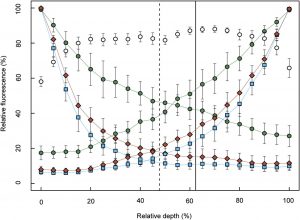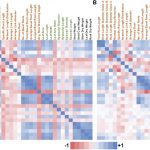The Spatial Distribution of Chlorophyll in Leaves
The biochemistry of photosynthesis and biophysical processes that constrain it are intrinsically linked within the landscape of the inner leaf. Because leaf tissue is heterogeneous in structure as well as photosynthetic capacity, it follows that chlorophyll may also be spatially heterogeneous. Yet, while bulk chlorophyll content of leaves can be readily measured, fewer studies have systematically dissected the leaf to determine how chlorophyll content is partitioned across the photosynthetic domain or mesophyll. The paucity of spatially resolved chlorophyll distribution data available at present is  likely due to the historically labor- and time-intensive processes of obtaining such data, requiring extraction of chlorophyll from thin paradermal sections or counting chloroplasts with a light microscope. However, epi-illumination measurement of chlorophyll fluorescence offers a simple and rapid method of measuring relative chlorophyll distribution within cell layers of a leaf. Borsuk & Brodersen (10.1104/pp.19.00094) have used epi-illumination fluorescence microscopy to estimate relative chlorophyll concentration as a function of mesophyll depth for 57 plant taxa. Despite interspecific variation due to differences in leaf thickness, mesophyll palisade fraction, and presence of large intercellular airspaces, the spatial distribution of chlorophyll in laminar leaves was remarkably well conserved across diverse lineages and growth habits. In the typical leaf, chlorophyll content increased gradually as a function of depth, peaking deep within the mesophyll. These findings represent an advancement towards more accurate modeling of photosynthesis.
likely due to the historically labor- and time-intensive processes of obtaining such data, requiring extraction of chlorophyll from thin paradermal sections or counting chloroplasts with a light microscope. However, epi-illumination measurement of chlorophyll fluorescence offers a simple and rapid method of measuring relative chlorophyll distribution within cell layers of a leaf. Borsuk & Brodersen (10.1104/pp.19.00094) have used epi-illumination fluorescence microscopy to estimate relative chlorophyll concentration as a function of mesophyll depth for 57 plant taxa. Despite interspecific variation due to differences in leaf thickness, mesophyll palisade fraction, and presence of large intercellular airspaces, the spatial distribution of chlorophyll in laminar leaves was remarkably well conserved across diverse lineages and growth habits. In the typical leaf, chlorophyll content increased gradually as a function of depth, peaking deep within the mesophyll. These findings represent an advancement towards more accurate modeling of photosynthesis.



